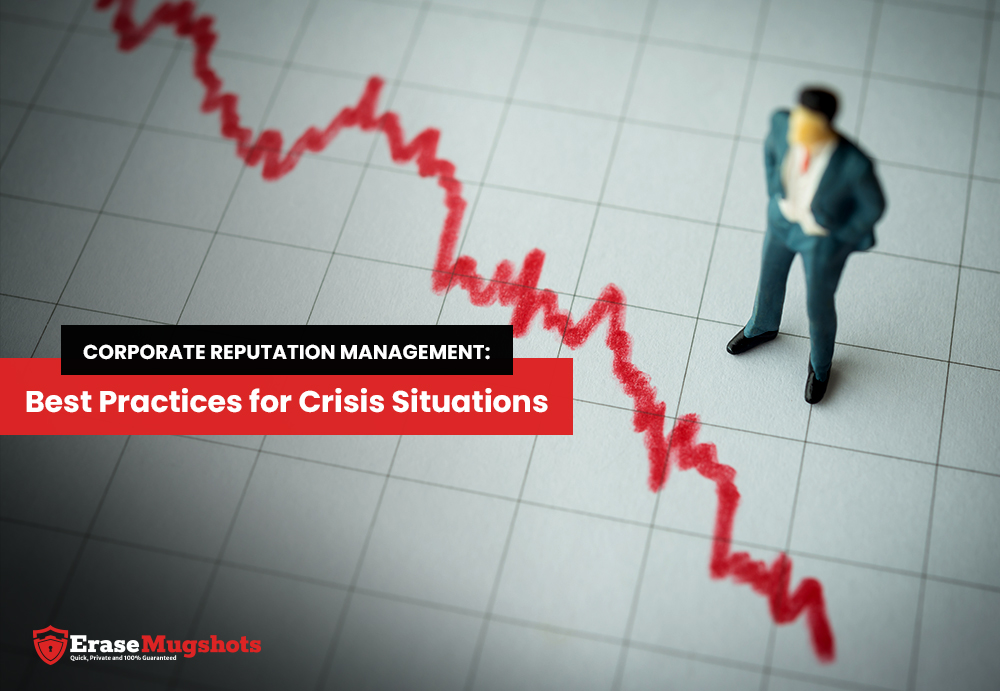100% Satisfaction Guaranteed
We offer a total mugshot removal solution to remove your mugshot and arrest details from the internet once and for all.

Table of Contents
Corporate reputation management is a catch-all term for everything that goes into monitoring and building a company’s public image. By maintaining a company’s image, you have better control over the spread of information and how the brand’s public identity affects business value.
However, when a crisis situation arises, even a well-honed and positive public image can be quickly ruined.
In this article, we’ll discuss how PR crises affect corporate reputation management and best practices for managing corporate reputation during a crisis.
For immediate help with corporate reputation management, contact us today at 866-601-6803 .

A corporate crisis is a situation that can lead to significant financial, operational or reputational damage — or a combination of them. These include:
A corporate crisis can quickly erode the public’s trust in the company and damage the brand’s corporate reputation.
The best way to understand the true impact of a PR crisis on corporate reputation is to look at real-life examples.

In September 2016, several employees of Wells Fargo created fake accounts in an effort to reach sales targets. Initially, Wells Fargo blamed the low-level employees instead of taking responsibility and being accountable for the company.
Eventually, as the true depth of the account fraud emerged, executive leadership did claim responsibility and CEO Tim Sloan stepped down. However, it took far too long for this to happen, leading to reputational damage for the company.
Regardless of the individuals involved in a company scandal, leadership should always take responsibility. This allows the company to take control from the beginning and maintain the trust it has built with investors and customers.

One of the largest crises that Facebook has faced is the Cambridge Analytica scandal that took place in the 2010s. Facebook gave permission to Cambridge Analytica, a consulting company, to collect data from 87 million users, which was then used in the 2016 election.
Once this information became public, Facebook reacted slowly and wasn’t transparent with users. Eventually, senior leadership explained what happened, why data was collected, and who was impacted. However, the delayed reaction meant that the damage was already done by the time it was addressed.
The lesson here is that the more time goes by before a situation is addressed by the company, the more chance it has to grow into an even larger crisis.

In October 2022, Elon Musk bought Twitter for $44 billion and quickly made several major changes to the company, including:
Not only was the rebranding quick and surprising but many of the steps Musk took weren’t announced before they took effect. This led to several accounts and advertisers jumping ship.
While X did rebound and ended up with other media placements, the bad PR likely had a lasting effect on many advertisers and users. It’s impossible to say how much success Musk could have seen with more thoughtful handling of the X takeover.

An integral part of PR crisis management is proactive planning. Gaining insight into vulnerabilities and knowing what to do should a crisis arise are key steps to getting through it as quickly as possible and limiting the damage it causes.
Corporate crisis planning includes strategies like the following:
Planning for a PR crisis includes the steps to prevent the crisis, specific instructions for what to do if the crisis occurs, and plans for rebuilding after the crisis. A crisis management plan should include templates for online conversations, contact information for pre-chosen spokespeople, and crisis simulations. All of this will help prepare the company for what to do in specific situations.
When a company is able to respond quickly to a crisis using pre-planned tactics for limiting damage, the easier it is to maintain a positive reputation.

Conducting a corporate reputation audit is a smart step toward preventing and preparing for a crisis. This process evaluates how the public views the company to assess the brand’s strengths, weaknesses and points of vulnerability.
An audit can also help the brand decide the audiences, communication channels and messages that have the biggest impact. When protecting or repairing a corporate reputation, the focus can go to these areas first to make the biggest impression on public perception.
For help with a corporate reputation audit, contact our ORM experts by calling 866-601-6803 .

As you saw in the real-life examples above, responding quickly and being transparent are necessary approaches if you want to minimize the damage to your corporate reputation.
The following steps should be part of a corporate crisis response.

Transparency is necessary for the public and business connections to continue trusting your company. Quickly acknowledge the situation so it doesn’t escalate and lead to rumors or the spread of misinformation.
In 2017, Pepsi came under fire for its now-infamous ad campaign starring Kendall Jenner.
While Pepsi first released a statement in defense of the campaign, the ad and campaign were pulled within 24 hours, followed by an apologetic statement.
Ultimately, Pepsi’s response to the crisis was swift and effective, and the brand showed its audience that they were empathetic to their concerns and would (and did) act on them.

A crisis can be complex, confusing and hectic. It’s necessary for your brand to gather factual information and data to accurately combat misinformation and prevent the spread of more incorrect info.
In 2015, after Chipotle faced a number of foodborne illness outbreaks, the dining chain closed restaurants in impacted areas to investigate and stop the spread of illness. Thanks to this dedication to collecting data, the company recognized the need for better safety measures, which they instituted and announced to the public.

Every brand needs a face that the public can associate with it. In the event of a PR crisis, your company needs a well-spoken, confident spokesperson to deliver messages to the public, investors and other affected parties.
Sometimes, seeing how a company handled a crisis poorly is the best way to decide how to handle it well.
During the Flint, Michigan, water crisis that took place from 2014 to 2016, Gary Southern, the president of Freedom Industries, served as the spokesperson. According to Wiser Strategies, Southern acted annoyed to be holding a press conference, didn’t express empathy for those impacted, and was even drinking water throughout the conference.
Several mistakes were made, including failing to show compassion, not admitting to wrongdoing, and being unaware of how body language and actions influence corporate reputation.

When navigating through a PR crisis, the company’s messaging should be empathetic, honest and transparent. It should also be consistent to avoid contradicting what you’ve already said.
From 2009 to 2010, Toyota dealt with several recalls that affected vehicles and driver safety throughout the world. Throughout the crisis, Toyota maintained transparent and consistent communication to acknowledge what went wrong, take responsibility, and regularly update customers and the media. Thanks to regular, open communication, the company was able to retain and re-establish trust to avoid complete reputational ruin.

As we’ve demonstrated, honesty and transparency are key elements of effective communication during a crisis. Keep these best practices in mind for corporate reputation management during a scandal:
The crisis is only the first issue that can impact your positive corporate reputation. How your company responds to the crisis is what matters most in many cases. A proper crisis response can mitigate damage, while improper responses can wreak more havoc and even cause irreparable devastation.
To speak with an expert about corporate reputation management during a crisis, call us at 866-601-6803 today.

Every company should have a corporate reputation management strategy that’s ready to go in the event of a crisis. However, good corporate reputation management goes far beyond crisis readiness. Many elements affect your company’s reputation, including:
With a proactive approach to corporate reputation management, you can develop a positive company reputation and online presence while encouraging customer loyalty. A positive brand reputation can also limit negative feedback and negative publicity from posting and spreading online.
When you develop brand authority, you gain a competitive advantage, encourage better Google reviews, and attract new customers to your business.
To speak with an ORM expert about effective corporate reputation management, call us today at 866-601-6803 .
We offer a total mugshot removal solution to remove your mugshot and arrest details from the internet once and for all.